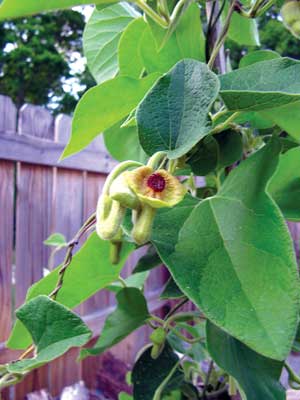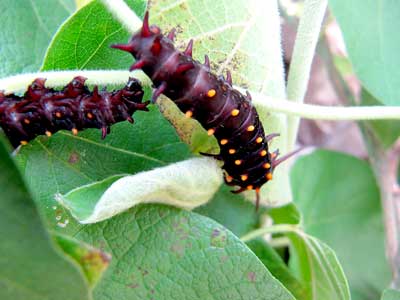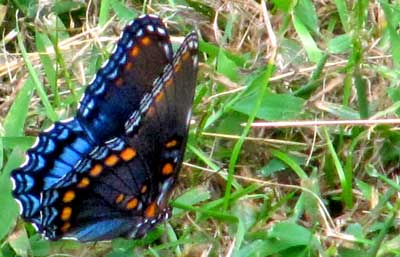
By Ken Moore
Flora Columnist
Recently, I received the following account from Flora reader Nancy Walker:
“Thanks to the North Carolina Botanical Garden, we (my gardening partner Maggie Roos-Codsi and I) planted three pipevines at Maggie’s house in Bahama two years ago. Little by little, the story of how this plant participates in the ‘big picture’ was revealed to us. The caterpillars that eat the pipevine leaves become poison feed to unwary predators of the ensuing pipevine swallowtail butterfly. As the predators ‘learn’ about that protection … they grant many species of ‘dark’ butterflies the same ‘immunity’ from attack, rather than risk the poison.â€
So we have here an example of mimicry, one of nature’s mysterious wonders.
In this case, through countless years of adaptation, some butterfly species have somehow developed color patterns similar to a species succeeding in becoming undesirable as a meal for predators.
Well now, the pipevine, or Dutchman’s pipe, Aristolochia macrophylla, is a luxuriantly growing vine of mountain-cove forests. Apparently, it will tolerate our harsh lowland Piedmont growing conditions. I’m always amazed when plants, by nature, restricted to the environmental conditions of the mountains, manage to survive here in our hot and dry Piedmont. The Botanical Garden has had one climbing around in a pawpaw tree for several years.
In late spring, flowers of pipevine are most engaging (see photo above) and do evoke an image of the Sherlock Holmes’ Dutchman’s smoking pipe. If any pipevine swallowtail butterflies are around, you can count on those spiny-looking, orange-pimpled, black larvae (caterpillars) devouring the entire vine. Don’t get out the spray can. The vines will recover soon after those ravenous caterpillars have moved on to their quiet resting stage before emerging as beautiful black-and-blue adults.
In addition to the pipevine swallowtails in the garden, Nancy and Maggie were able to capture, in photos from some distance away, the red-spotted purple butterfly, so similar in appearance that it is unlikely to become a meal for numerous potential predators.
You can observe nature’s mimicry in your garden by growing pipevines of your own. Unfortunately, the Botanical Garden has no more pipevine plants available this year. However, Niche Gardens has plants of a closely related species, the wooly Dutchman’s pipe, Aristolochia tomentosa, which naturally occurs in South Carolina and is successfully cultivated here in our area. It also is a preferred food plant of larvae of the pipevine swallowtail. Larvae of the mimic red-spotted purple feed on wild willow and black cherry, two tree species very common in our area.
In addition to enjoying the flowers of your Dutchman’s pipevines, you can develop skills distinguishing the two butterfly species.
Many thanks to Nancy and Maggie for sharing their pipevine story.
Email Ken Moore at flora@carrborocitizen.com.



